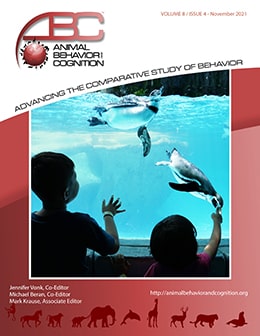Vol 8, Issue 4, November 2021
Behavioral Responses of Captive Corvids to the Presence of Visitors
Citation
Wascher, C. A. F., Baur, N., Hengl, M., Köck, C., Pegger, T., Schindlbauer, J., & Wemer, L. (2021). Behavioral responses of captive corvids to the presence of visitors. Animal Behavior and Cognition, 8(4), 481-492. https://doi.org/10.26451/abc.08.04.03.2021
Abstract
Behavioral responses of captive animals to the presence of visitors in zoos and wildlife parks can be interpreted as signs of negative (disturbance), neutral or positive (enrichment) welfare. In the present study, we investigated behavioral responses of captive common ravens, Corvus corax and crows, Corvus corone, to the presence of visitors in general and to the proximity or distance of visitors to the aviary respectively. Duration of affiliative behaviors, feeding and stress-related behaviors did not change when visitors were present compared to control situations without visitors being present. Both corvid species showed less head up behavior when visitors were in sight compared to the control condition. In contrast, preening of crows significantly increased when visitors were within two meters of the aviary compared to the control condition. The same relationship was found in regard to increase in vocalization for common ravens, but not for crows. Our results indicate that corvids, housed in a wildlife park for several years, still show behavioral responses to the presence of human visitors in close proximity to their enclosure. Overall, we did not find clear indications for reduced welfare due to visitor presence, such as increased locomotion or stress-related behaviors. We therefore conclude that the described behavioral changes are not indicative of any negative welfare impacts of visitor presence.
Keywords
Animal welfare, Crows, Common ravens, Visitor effects
